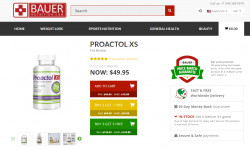In today’s fast-paced world, where pushing through pain is often seen as a badge of honor, finding an effective pain reliever is more crucial than ever. Aleve Pain Reliever stands out as a beacon of relief for many, offering a promise of longer-lasting alleviation from various aches and pains. In this review, we will delve deep into what makes Aleve a go-to choice for those seeking solace from discomfort. From its active ingredient, naproxen sodium, to its ability to target pain at its source, Aleve offers a compelling narrative in the crowded over-the-counter pain relief market. Whether you’re battling arthritis, muscle aches, back pain, or a relentless headache, understanding how Aleve works can be the first step towards regaining control of your day. Join me as we explore the efficacy, usage, and safety of Aleve Pain Reliever, and discover why it might just be the pain management solution you’ve been searching for.
Ingredients of Aleve Pain Reliever
Here’s a list of Aleve Pain Reliever ingredients and information about each:
- Active Ingredient:
- Naproxen Sodium: 220 mg per tablet. It’s a nonsteroidal anti-inflammatory drug (NSAID) that serves as the active ingredient in Aleve, providing pain relief and fever reduction.
- Inactive Ingredients:
- FD&C Blue #2 Lake: A dye used for coloring the tablet.
- Hypromellose: A polymer used as an excipient and controlled-delivery component.
- Magnesium Stearate: An anti-adherent used to prevent ingredients from sticking to manufacturing equipment.
- Microcrystalline Cellulose: A bulking agent that helps create the desired tablet size and absorbency.
- Polyethylene Glycol: Used as a plasticizer, solvent, and lubricant in the tablet.
- Povidone: A binder that helps the tablet ingredients stick together.
- Talc: A filler and anti-caking agent that prevents the tablet ingredients from clumping.
- Titanium Dioxide: Provides the tablet with its white color.
Each Aleve tablet also contains 20 mg of sodium, classified as “low sodium” under FDA guidelines. Aleve’s formulation is designed to temporarily relieve minor aches and pains due to conditions such as arthritis, muscular aches, backache, menstrual cramps, headache, toothache, and the common cold, as well as to temporarily reduce fever.
Potential Side Effects of Aleve Pain Reliever
Aleve (naproxen) is an over-the-counter nonsteroidal anti-inflammatory drug (NSAID) that can cause a range of side effects. These side effects can vary from common and less severe to rare and potentially serious. Below is a summary of potential side effects of Aleve, categorized for clarity:
- Common Side Effects:
- Skin discoloration, swelling, or soreness
- Shakiness, seizures, severe sunburn
- Stiff neck or back, stomach cramps or tenderness
- Swelling in legs and ankles, swollen lymph glands
- Unexplained weight loss, watery or bloody diarrhea
- Symptoms of Overdose:
- Bleeding under the skin, confusion, muscle tremors
- Restlessness, sleepiness
- Less Common Side Effects:
- Acid or sour stomach, change in hearing
- Feeling of constant movement, passing gas
- Sensation of spinning, stomach soreness
- Rare Side Effects:
- Appetite changes, burning or tingling feelings
- Difficulty with moving, menstrual changes
- Not able to concentrate, redness or swelling of the eye
- For Healthcare Professionals (detailed information on gastrointestinal, hepatic, nervous system, renal, cardiovascular, hematologic, hypersensitivity, dermatologic, respiratory, metabolic, and other effects).
It’s important to consult healthcare professionals if experiencing any of these side effects or if there are concerns about taking Aleve, especially in the context of other medical conditions or medications. For a comprehensive list and detailed descriptions, please refer to the information provided on Drugs.com and Mayo Clinic.
What people are saying about Aleve Pain Reliever
People’s experiences with Aleve Pain Reliever (Naproxen) vary widely, reflecting its effectiveness for some and adverse reactions for others. Many users have reported significant relief from various types of pain, including back pain, sciatica, arthritis, period pain, and pain from injuries like broken wrists. For instance, users have shared stories of finding relief from severe back pain after strenuous activities, experiencing reduced inflammation and increased mobility, and even avoiding surgery for conditions like sciatica by using Aleve regularly. It has also been highlighted for its effectiveness in managing acute gout, reducing severe period pain, and assisting with recovery from dental procedures, with some users preferring it over other over-the-counter medications for its longer-lasting effect.
However, not all feedback is positive. Some users have reported experiencing no relief from their pain or suffering from severe side effects such as gastrointestinal issues, diarrhea, stomach pain, and even symptoms like heart palpitations and chest pain after taking Aleve. The severity of side effects has led some to regret trying it, and others to caution potential users to consider other pain management options or consult with a healthcare provider before taking Aleve, especially if they have underlying health conditions or are sensitive to NSAIDs.
It’s important for individuals to consult with their healthcare provider before starting any new medication, including Aleve, to discuss potential risks and benefits based on their health history and condition. While Aleve has been a game-changer for many in managing pain, its use is not without risks, and personal experiences highlight the importance of using it judiciously and under medical advice.
About the company behind Aleve Pain Reliever
The company behind Aleve, a popular nonsteroidal anti-inflammatory drug (NSAID) used for pain relief, is Bayer HealthCare. Aleve’s active ingredient is naproxen, which is marketed under various brand names including Aleve and Naprosyn among others. It was first introduced to the market by Syntex in 1976 and has since become available in many countries, with varying regulations regarding prescription and over-the-counter sales. In the United States, Aleve was approved for over-the-counter use by the Food and Drug Administration (FDA) in 1994.
A look at Aleve Pain Reliever’s BBB profile
Bayer Healthcare, LLC, the company behind Aleve Pain Reliever, has a profile on the Better Business Bureau (BBB) with an A rating. However, it’s not BBB accredited. Their BBB profile indicates a history of 161 years in business, with the company having been established in 1863. There are a few customer complaints and reviews listed, which are typical for a company of its size and reach.
Where to buy and price of Aleve Pain Reliever
Aleve Pain Reliever is available for purchase at several retail outlets, including Walgreens. Prices vary depending on the product type and quantity. For instance, Aleve Pain Reliever & Fever Reducer Naproxen Sodium Tablets (90 Ea) are priced at approximately $15.99 each at Walgreens. There are also options for liquid gels and different quantities, such as the Aleve Pain Reliever & Fever Reducer Liquid Gel (80 Ea) available for around $17.49 and the Aleve Pain Reliever & Fever Reducer Naproxen Sodium Caplets (200 Ea) for about $24.99. These prices and availability may vary from online to in-store purchases, and promotions such as “Buy 1, Get 1 50% OFF” and discounts for spending a certain amount may apply.
What is the refund policy of Aleve Pain Reliever
I couldn’t find any information
Aleve Pain Reliever contact information
For inquiries about Aleve, you can contact them at 1-800-395-0689, available Monday through Friday from 9 AM to 5 PM EST.
Pros and cons of Aleve Pain Reliever
Aleve, a nonsteroidal anti-inflammatory drug (NSAID), offers both benefits and potential side effects for users. Here’s a summary of the pros and cons based on information from Drugs.com:
Pros:
- Effective for Pain Relief: Aleve is used to relieve minor aches and pains from conditions like arthritis, muscular aches, backache, menstrual cramps, headache, toothache, and the common cold. It also reduces fever.
- Dosage Flexibility: Aleve can be used as needed, and doses are based on weight for children, offering some flexibility in its use.
- Longer Duration: Compared to some other NSAIDs, Aleve has a longer action time, allowing for less frequent dosing.
Cons:
- Risk of Side Effects: Common side effects may include indigestion, heartburn, stomach pain, nausea, headache, dizziness, drowsiness, bruising, itching, rash, swelling, and ringing in the ears. Serious side effects can include allergic reactions, heart attack or stroke symptoms, liver and kidney problems, anemia, and severe skin reactions.
- Potential for Overdose: Symptoms of overdose can include bleeding under the skin, confusion, muscle tremors, restlessness, and sleepiness.
- Drug Interactions: Aleve may interact with other medications, including antidepressants, blood thinners, diuretics, heart, or blood pressure medication, increasing the risk of complications.
- Avoidance with Other NSAIDs: It’s advised to avoid taking aspirin or other NSAIDs unless directed by a doctor to prevent the risk of stomach bleeding.
- Alcohol Caution: Drinking alcohol while taking Aleve may increase the risk of stomach bleeding.
It’s important to use Aleve as directed and consult a healthcare provider for personalized advice, especially if you’re considering long-term use or if you have existing health conditions that might be affected by NSAID use.
Is Aleve Pain Reliever worth a try?
Deciding whether Aleve Pain Reliever is worth a try involves considering its effectiveness, how it works, potential side effects, and comparisons with other pain relievers. Aleve, containing naproxen as an active ingredient, is a nonsteroidal anti-inflammatory drug (NSAID) used to relieve pain from various conditions such as arthritis, muscular aches, backache, menstrual cramps, headache, and toothache. It works by reducing hormones that cause inflammation and pain in the body.
Aleve starts to work within 30 minutes to 1 hour, with its peak effect occurring within 2-4 hours. The drug has a long half-life of 12-17 hours, meaning its pain-relieving effects can last longer compared to some other over-the-counter (OTC) pain relievers. This extended effect is one of the reasons it might be considered worth trying for those seeking longer-lasting pain relief.
However, it’s essential to be aware of the potential side effects and risks associated with Aleve. Common side effects can include indigestion, heartburn, stomach pain, nausea, headache, dizziness, drowsiness, bruising, itching, rash, swelling, and ringing in your ears. More serious side effects might involve allergic reactions, heart attack or stroke symptoms, liver problems, kidney issues, anemia, and severe skin reactions. It’s crucial to avoid alcohol while taking Aleve to reduce the risk of stomach bleeding and be cautious about combining it with other NSAIDs, certain antidepressants, and various other medications to prevent adverse interactions.
Comparatively, Aleve (naproxen) may start working slightly slower than acetaminophen (Tylenol) but faster than ibuprofen (Advil) in some cases. However, its longer duration of action makes it a valuable option for managing pain that requires sustained relief over time.
Aleve Pain Reliever FAQ
- What is Aleve?
Aleve is an over-the-counter, nonsteroidal anti-inflammatory drug (NSAID) that provides temporary relief from a variety of minor aches and pains and also reduces fever. The active ingredient in Aleve is 220 mg of naproxen sodium. - What conditions can Aleve treat?
Aleve can temporarily relieve minor aches and pains due to conditions such as arthritis, headaches, muscular aches, toothaches, backache, the common cold, and menstrual cramps. It also reduces fever. - How does Aleve work?
Aleve blocks the production of prostaglandins, which are chemicals in the body that play a direct role in pain and inflammation. - What are the advantages of using Aleve over other pain relievers?
Aleve offers the convenience of less frequent dosing, requiring fewer pills for all-day relief. Just 2 pills can provide pain relief that lasts all day, with each pill having the strength to last 12 hours. - How does Aleve interact with other drugs?
Aleve can interact with various medications, including certain antidepressants, blood thinners, heart or blood pressure medication, and more. It’s essential to consult with a doctor before combining Aleve with other drugs. - What are common side effects of Aleve?
Common side effects may include indigestion, heartburn, stomach pain, nausea, headache, dizziness, drowsiness, bruising, itching, rash, swelling, or ringing in the ears. Serious side effects could involve heart attack or stroke symptoms, liver problems, kidney issues, severe skin reactions, or signs of stomach bleeding. - Are there specific safety considerations when using Aleve?
Yes, there are health conditions and scenarios where caution is advised, such as if you have heart disease, high blood pressure, diabetes, a history of stomach ulcers or bleeding, asthma, liver or kidney disease, or if you’re pregnant or breastfeeding. Aleve is not approved for use by anyone younger than 2 years old without medical advice.




![Turmitrinol Review [year] - Side Effects & Ingredients Turmitrinol Review ([year]) - Side Effects & Ingredients](https://www.miriamwellness.com/wp-content/uploads/2023/11/Turmitrinol-Review-2023-Side-Effects-Ingredients-150x150.jpg)
![Pruvit KETO OS Review [year] - Side Effects & Ingredients Pruvit KETO OS Review ([year]) - Side Effects & Ingredients](https://www.miriamwellness.com/wp-content/uploads/2023/11/Pruvit-KETO-OS-Review-2023-Side-Effects-Ingredients-150x150.jpg)
![LA-3 Review [year] - Side Effects & Ingredients LA-3 Review ([year]) - Side Effects & Ingredients](https://www.miriamwellness.com/wp-content/uploads/2023/11/LA-3-Review-2023-Side-Effects-Ingredients-150x150.jpg)
![Thrive Patch Review [year] - Side Effects & Ingredients Thrive Patch Review ([year]) - Side Effects & Ingredients](https://www.miriamwellness.com/wp-content/uploads/2023/11/Thrive-Patch-Review-2023-Side-Effects-Ingredients-150x150.jpg)